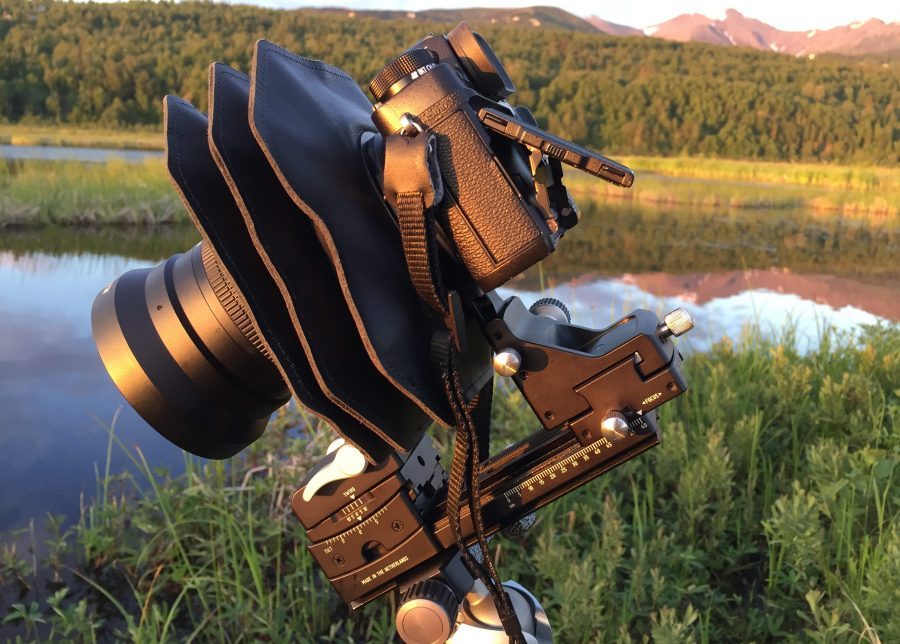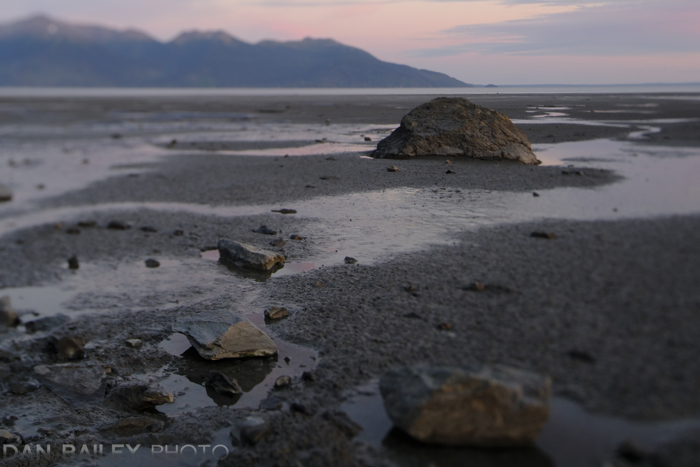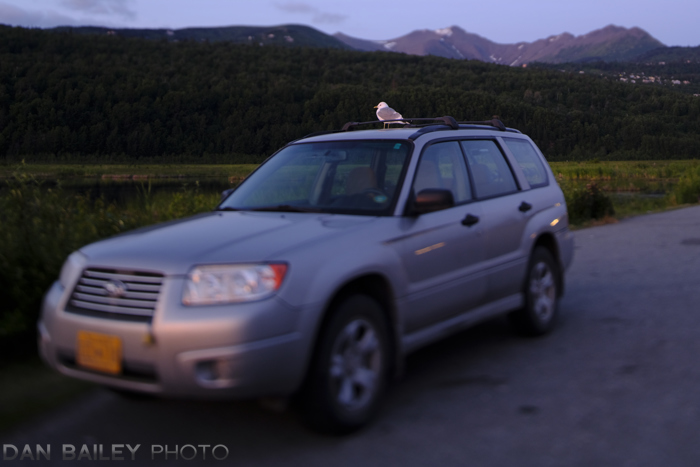 Earlier this summer, I had the chance to try out the Actus Mini View Camera For Fujfilm X Series, manufactured by Cambo Photo. This innovative and well-crafted device turns your mirrorless Fuji into a high quality, and highly portable view camera, and allows you to shoot highly stylized photos that would otherwise be impossible to capture.
Earlier this summer, I had the chance to try out the Actus Mini View Camera For Fujfilm X Series, manufactured by Cambo Photo. This innovative and well-crafted device turns your mirrorless Fuji into a high quality, and highly portable view camera, and allows you to shoot highly stylized photos that would otherwise be impossible to capture.
Consisting of a monorail base, a camera mount plate and a flexible bellow, and an add-on lens mount and lens, the Actus Mini allows you attach any X Series camera as a digital back. This lets you perform traditional tilt, shift and swing motions and add an enormous amount of creative and professional quality options to your photography.


Exact configurations vary depending on which lens you use. At this point, you cannot use your own Fuji lenses with the Actus, however you can order optional lens plates which allow you to use the Actus with Hassleblad, Mamiya, Pentax 645, Leica R, Nikon-F and Canon-EOS lenses. So, for example you could use your X-T2 or X-E1 on the Actus with a Hassleblad or Nikon lens if you so choose.
Currently, Cambo has three of their own lenses designed for their Actus mirrorless camera system, a 24mm, a 60mm lens and an 80mm. The unit I used shipped with the German made ACTAR 24mm f/3.5 lens. It’s bigger than any Fujinon lens, but it’s an incredible piece of glass.
Constructed with 6 multi-coated elements in 11 groups, the ACTUS 24mm is an exceptional architecture and landscape lens that produces almost no distortion. I was extremely pleased with how it performed when shooting a wide variety of landscapes, nature and even a few people photos.
Before we get into all that, though I need to tell you how it works.

Setup and Operation
The Actus rig came packed into small Pelican Case as three pieces: the monorail, the lens and the bellows. Don’t tell the Cambo guys this, but I didn’t use the Peli case all week, I just stuffed the gear into one of my LowePro packs. It actually fit perfectly, which illustrates just how portable is rig really is.
Once on location, it’s extremely easy to assemble. You place the monorail onto your tripod, remove rear lens cap and slide the lens onto the lens mounting plate, attach your camera to the rear camera mounting plate and slip the bellows in between. The bellows have magnetic plates on both sides, so they simply snap right to both sides and create your light seal.
From start to finish, we’re talking less than five minutes. Probably three if you’re methodical and careful. Once its all put together, the fun begins.
The all-metal monorail is extremely well crafted with a high level of precision engineering. It feels very substantial, like you’re using a truly professional piece of equipment. The four large knobs control your tilt, shift, swing and focus controls. There’s also a small knob that locks your focus so it doesn’t accidentally drift or get bumped.
It’s also highly modular. You can order different lens plates, different lenses and a variety of bayonet plates for using the Actus Mini with other camera brands as well, including Nikon, Canon, Sony, Olympus, Pentax.

 Tilt, Shift and Swing
Tilt, Shift and Swing
If you’ve never used a real view camera before, (I hadn’t) it can be a little intimidating at first. However, it’s a simple matter of trial and error to figure out how it all works.
Basically, with a view camera you can tilt the lens up and down, swing it from side to side, and shift the body up and down behind the lens, or side to side. This allows you to get those special “tilt shift” effects, where your plane of sharp focus can vary from very wide through entire picture, to narrow slices of focus that run up and down, across, or even diagonally through your frame.
If you’re familiar with the ADV Miniature Mode on the Fuji cameras, it’s like that, only with way more control. Depending on your lens aperture, camera orientation and how you control the knobs you can create a wide or very narrow focus slice anywhere in the frame. You can make it run vertically or horizontally across the frame, and you can fine tune exactly where your point of sharp focus will be.


Focus control is accomplished by turning the focus dial on the back of the ACTUS. As with a traditional view camera, you gauge your focus by looking at the camera’s LCD screen, or through the viewfinder. Only you don’t need a big piece of cloth over your head to gauge your precision, you have a much more powerful tool.
Setting your X Series camera’s Manual Focus Assist setting to Focus Peaking (I use red peaking) allows you to easily see exactly what’s in focus. This is perhaps the most beneficial aspect of having a mirrorless view camera. You can turn the focus knob and watch the field of red highlights move back and forth or side to side across your frame, which allows exceptionally quick fine tuning of your focus.
Tilting the lens up and down creates differences in focus from top to bottom in your frame. This allows you to create those miniature effects, and the amount of blur is controlled by how much you tilt he lens and by your aperture setting.
Swinging the lens side by side give you the same kind of effect, but on the vertical axis. So instead of having top and bottom blur, you can have strips of blur on either side of the frame, or vary focus left and right across the frame.
Shifting the camera up and down keeps vertical lines parallel to your film (sensor) plane and controls parallax error when shooting architecture. It also helps you control and fine tune your framing since tilting the lens up and down can affect what is shown in your viewfinder.
Shifting the camera back and forth does the same thing as shifting up and down, but on the vertical axis. It also helps when shooting shoot images you plan to stitch together as panoramas. Shifting the camera on a tripod like this instead of moving the whole camera, like most people do, allows you to dramatically reduce distortion effects when shooting multiple frames across you field of view.
Selective Focus Fun!!
The creative options with a view camera are huge and so the ACTUS greatly expands the photographic possibilities you can achieve with your Fuji. Since they all have the same mount, the Actus Mini will work with any APS-C sensor X Series camera, and will open up your creative boundaries in ways you never would have imagined.
I had a blast shooting with the ACTUS Mini for Fuji and after I got the hang of how the focus and all the knobs work, I felt pretty adept at getting the effects I wanted. The focus peaking setting on the Fuji REALLY helped and made an enormous difference in my experience with the ACTUS Mini.
The best part about the Actus Mini is that it perfectly compliments the compact, lightweight nature of the Fuji cameras. Although the Actus rig itself isn’t exceptionally small, it’s certainly compact and light enough to carry easily into the backcountry. During my week with the Actus, I did a couple of 3-4 hour hikes with it and felt no noticeable burden and even carried it up onto a glacier.
The Actus Mini isn’t cheap by any means. After you buy the camera, whichever lens you choose and the corresponding lens mount, you’ve spent more than what any X Series camera body or lens costs. However, not as much as some of the big DSLR glass that many photographers buy without thinking.
However, if you’re really interested in using a view camera and opening up your photography options, and you have the budget, the Actus Mini is one cool piece of gear. Consider it an investment in your creativity. It’s something that would easily last a lifetime, especially since you can order different body mounts for use with other camera systems.
Cambo also has the ACTUS-GFX, which offers the same design for GFX users. Given the ultra high resolution and clarity of the medium format GFX camera, this seems like an incredible combination. It’s probably the best modern view camera you could own right now. Definitely a must have for the most serious of landscape and architecture photographers.
Check out the Actus Mini for Fujifilm X at the Cambo Photo website, or price out your desired options for the Actus Mini at B&H Photo.
Also, check out my video review to see the Actus Mini in action below.



